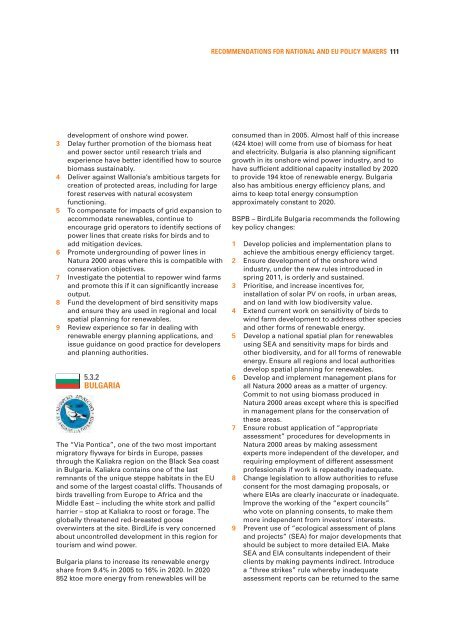Meeting Europe's renewable energy targets in harmony with - RSPB
Meeting Europe's renewable energy targets in harmony with - RSPB
Meeting Europe's renewable energy targets in harmony with - RSPB
Create successful ePaper yourself
Turn your PDF publications into a flip-book with our unique Google optimized e-Paper software.
RECOMMENDATIONS FOR NATIONAL AND EU POLICY MAKERS 111<br />
development of onshore w<strong>in</strong>d power.<br />
3 Delay further promotion of the biomass heat<br />
and power sector until research trials and<br />
experience have better identified how to source<br />
biomass susta<strong>in</strong>ably.<br />
4 Deliver aga<strong>in</strong>st Wallonia’s ambitious <strong>targets</strong> for<br />
creation of protected areas, <strong>in</strong>clud<strong>in</strong>g for large<br />
forest reserves <strong>with</strong> natural ecosystem<br />
function<strong>in</strong>g.<br />
5 To compensate for impacts of grid expansion to<br />
accommodate <strong>renewable</strong>s, cont<strong>in</strong>ue to<br />
encourage grid operators to identify sections of<br />
power l<strong>in</strong>es that create risks for birds and to<br />
add mitigation devices.<br />
6 Promote underground<strong>in</strong>g of power l<strong>in</strong>es <strong>in</strong><br />
Natura 2000 areas where this is compatible <strong>with</strong><br />
conservation objectives.<br />
7 Investigate the potential to repower w<strong>in</strong>d farms<br />
and promote this if it can significantly <strong>in</strong>crease<br />
output.<br />
8 Fund the development of bird sensitivity maps<br />
and ensure they are used <strong>in</strong> regional and local<br />
spatial plann<strong>in</strong>g for <strong>renewable</strong>s.<br />
9 Review experience so far <strong>in</strong> deal<strong>in</strong>g <strong>with</strong><br />
<strong>renewable</strong> <strong>energy</strong> plann<strong>in</strong>g applications, and<br />
issue guidance on good practice for developers<br />
and plann<strong>in</strong>g authorities.<br />
5.3.2<br />
BULGARIA<br />
The “Via Pontica”, one of the two most important<br />
migratory flyways for birds <strong>in</strong> Europe, passes<br />
through the Kaliakra region on the Black Sea coast<br />
<strong>in</strong> Bulgaria. Kaliakra conta<strong>in</strong>s one of the last<br />
remnants of the unique steppe habitats <strong>in</strong> the EU<br />
and some of the largest coastal cliffs. Thousands of<br />
birds travell<strong>in</strong>g from Europe to Africa and the<br />
Middle East – <strong>in</strong>clud<strong>in</strong>g the white stork and pallid<br />
harrier – stop at Kaliakra to roost or forage. The<br />
globally threatened red-breasted goose<br />
overw<strong>in</strong>ters at the site. BirdLife is very concerned<br />
about uncontrolled development <strong>in</strong> this region for<br />
tourism and w<strong>in</strong>d power.<br />
Bulgaria plans to <strong>in</strong>crease its <strong>renewable</strong> <strong>energy</strong><br />
share from 9.4% <strong>in</strong> 2005 to 16% <strong>in</strong> 2020. In 2020<br />
852 ktoe more <strong>energy</strong> from <strong>renewable</strong>s will be<br />
consumed than <strong>in</strong> 2005. Almost half of this <strong>in</strong>crease<br />
(424 ktoe) will come from use of biomass for heat<br />
and electricity. Bulgaria is also plann<strong>in</strong>g significant<br />
growth <strong>in</strong> its onshore w<strong>in</strong>d power <strong>in</strong>dustry, and to<br />
have sufficient additional capacity <strong>in</strong>stalled by 2020<br />
to provide 194 ktoe of <strong>renewable</strong> <strong>energy</strong>. Bulgaria<br />
also has ambitious <strong>energy</strong> efficiency plans, and<br />
aims to keep total <strong>energy</strong> consumption<br />
approximately constant to 2020.<br />
BSPB – BirdLife Bulgaria recommends the follow<strong>in</strong>g<br />
key policy changes:<br />
1 Develop policies and implementation plans to<br />
achieve the ambitious <strong>energy</strong> efficiency target.<br />
2 Ensure development of the onshore w<strong>in</strong>d<br />
<strong>in</strong>dustry, under the new rules <strong>in</strong>troduced <strong>in</strong><br />
spr<strong>in</strong>g 2011, is orderly and susta<strong>in</strong>ed.<br />
3 Prioritise, and <strong>in</strong>crease <strong>in</strong>centives for,<br />
<strong>in</strong>stallation of solar PV on roofs, <strong>in</strong> urban areas,<br />
and on land <strong>with</strong> low biodiversity value.<br />
4 Extend current work on sensitivity of birds to<br />
w<strong>in</strong>d farm development to address other species<br />
and other forms of <strong>renewable</strong> <strong>energy</strong>.<br />
5 Develop a national spatial plan for <strong>renewable</strong>s<br />
us<strong>in</strong>g SEA and sensitivity maps for birds and<br />
other biodiversity, and for all forms of <strong>renewable</strong><br />
<strong>energy</strong>. Ensure all regions and local authorities<br />
develop spatial plann<strong>in</strong>g for <strong>renewable</strong>s.<br />
6 Develop and implement management plans for<br />
all Natura 2000 areas as a matter of urgency.<br />
Commit to not us<strong>in</strong>g biomass produced <strong>in</strong><br />
Natura 2000 areas except where this is specified<br />
<strong>in</strong> management plans for the conservation of<br />
these areas.<br />
7 Ensure robust application of “appropriate<br />
assessment” procedures for developments <strong>in</strong><br />
Natura 2000 areas by mak<strong>in</strong>g assessment<br />
experts more <strong>in</strong>dependent of the developer, and<br />
requir<strong>in</strong>g employment of different assessment<br />
professionals if work is repeatedly <strong>in</strong>adequate.<br />
8 Change legislation to allow authorities to refuse<br />
consent for the most damag<strong>in</strong>g proposals, or<br />
where EIAs are clearly <strong>in</strong>accurate or <strong>in</strong>adequate.<br />
Improve the work<strong>in</strong>g of the “expert councils”<br />
who vote on plann<strong>in</strong>g consents, to make them<br />
more <strong>in</strong>dependent from <strong>in</strong>vestors’ <strong>in</strong>terests.<br />
9 Prevent use of “ecological assessment of plans<br />
and projects” (SEA) for major developments that<br />
should be subject to more detailed EIA. Make<br />
SEA and EIA consultants <strong>in</strong>dependent of their<br />
clients by mak<strong>in</strong>g payments <strong>in</strong>direct. Introduce<br />
a “three strikes” rule whereby <strong>in</strong>adequate<br />
assessment reports can be returned to the same
















